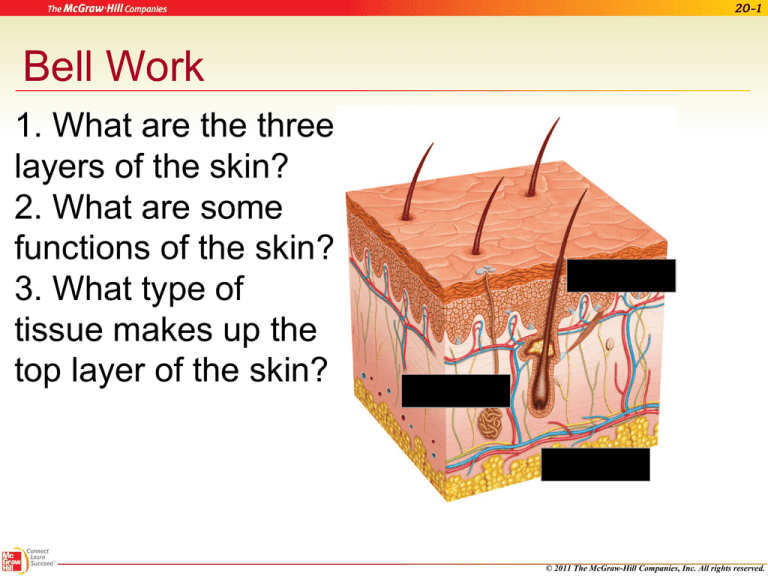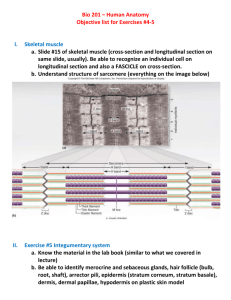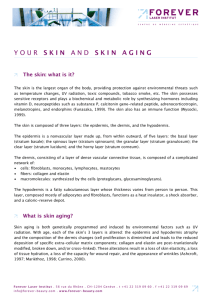
20-1
Bell Work
1. What are the three
layers of the skin?
2. What are some
functions of the skin?
3. What type of
tissue makes up the
top layer of the skin?
© 2011 The McGraw-Hill Companies, Inc. All rights reserved.
20-2
What happens to your skin when you get a sunburn?
https://www.youtube.com/watch?
v=jWwGRgHqKPY
© 2011 The McGraw-Hill Companies, Inc. All rights reserved.
20-3
Learning Outcomes
1. List the functions of skin.
2. Explain the role of skin in regulating body
temperature.
3. Identify the layers of skin and describe the
characteristics of each.
© 2011 The McGraw-Hill Companies, Inc. All rights reserved.
20-4
Integumentary System
© 2011 The McGraw-Hill Companies, Inc. All rights reserved.
20-5
Introduction
•
Integumentary
system consists
of skin and its
accessory organs
•
Accessory
organs:
– Hair follicles
– Nails
– Skin glands
Skin is the body’s outer covering and its largest
organ.
© 2011 The McGraw-Hill Companies, Inc. All rights reserved.
20-6
Functions of the Integumentary System
•
Protection
– First line of defense against
Bacteria
• Viruses
•
– Protects underlying
structures from
Ultraviolet (UV) radiation
• Dehydration
•
© 2011 The McGraw-Hill Companies, Inc. All rights reserved.
20-7
Functions of the Integumentary System
(cont.)
•
Body temperature
regulation
– If too hot
Dermal blood vessels dilate
• Vessels carry more blood to
surface so heat can escape
•
– If too cold
Dermal blood vessels constrict
• Prevents heat from escaping
•
© 2011 The McGraw-Hill Companies, Inc. All rights reserved.
20-8
Functions of the Integumentary System
(cont.)
•
Vitamin D production
– Needed for calcium absorption
•
Sensation
– Sensory receptors
•
Excretion
– Small amounts of waste products
are lost through perspiration
© 2011 The McGraw-Hill Companies, Inc. All rights reserved.
20-9
Apply Your Knowledge
From what you have learned so far, what are
some of the functions of the integumentary
system?
© 2011 The McGraw-Hill Companies, Inc. All rights reserved.
20-10
Structure of Skin
• Epidermis
• Dermis
• Hypodermis
or subcutaneous
layer
Back
© 2011 The McGraw-Hill Companies, Inc. All rights reserved.
20-11
Epidermis
The epidermis of thick skin has five layers:
1. stratum basale
2. stratum spinosum
3. stratum granulosum
4. stratum lucidum
5. stratum corneum
© 2011 The McGraw-Hill Companies, Inc. All rights reserved.
20-12
© 2011 The McGraw-Hill Companies, Inc. All rights reserved.
20-13
Epidermis (cont.)
• Keratinocyte – most common
- Makes and accumulates keratin
• Durable protein that makes the epidermis
waterproof and resistant to pathogens
• Melanocyte
- Makes the pigment melanin
• Traps UV radiation and prevents damage to
underlying layers of the skin
• Merkel cells
- Associated with sensory nerve endings. Sensitive to
touch. Abundant on the surfaces of the hands and feet
© 2011 The McGraw-Hill Companies, Inc. All rights reserved.
20-14
Epidermis
• Most superficial layer
– Stratum corneum
• Outermost layer
• Mostly dead cells form an impermeable layer
– Stratum basale (stratum germinativum)
• Deepest layer
• Cells constantly dividing and pushing older cells
outward
To Figure of Skin
© 2011 The McGraw-Hill Companies, Inc. All rights reserved.
20-15
Epidermis
Stratum lucidum- Above stratum
granulosum. Appears transparent due to
eleiden, a clear protein rich in lipids.
Stratum granulosum- Above stratum
spinosum. Generates large amounts of
keratin. Grainy appearance due to
keratinocytes.
Stratum spinosum- Above stratum
basale. Composed of keratinocytes.
© 2011 The McGraw-Hill Companies, Inc. All rights reserved.
20-16
Dermis
•
•
It contains blood and lymph vessels,
nerves, and other structures, such as hair
follicles and sweat glands.
The dermis is made of two layers of
connective tissue that compose an
interconnected mesh of elastin and
collagenous fibers, produced by
fibroblasts
© 2011 The McGraw-Hill Companies, Inc. All rights reserved.
20-17
Dermis
Papillary layer - made of loose, areolar
connective tissue, which means the
collagen and elastin fibers of this layer
form a loose mesh.
Reticular layer -Thick, composed of
dense, irregular connective tissue.
© 2011 The McGraw-Hill Companies, Inc. All rights reserved.
20-18
Subcutaneous Layer
• Hypodermis
• Composed of
– Adipose (fat) and loose connective tissue
– Blood vessels and nerves
• Functions
– Maintains body temperature
– Cushions and insulates underlying
structures
To Figure of Skin
© 2011 The McGraw-Hill Companies, Inc. All rights reserved.
20-19
Apply Your Knowledge
From what we have learned, what are some things
you learned about the epidermis, dermis, or
hypodermis?
© 2011 The McGraw-Hill Companies, Inc. All rights reserved.
20-20
LET’S DRAW AND LABEL!
© 2011 The McGraw-Hill Companies, Inc. All rights reserved.





